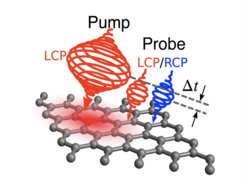Topological states caught in the act
In the past decade, quantum materials science has seen a surge in the quest for topological materials. The properties exhibited by these materials at their boundaries differ greatly from those inside. Topological insulators are a striking example: While they do not conduct electricity in their bulk they do channel it along their surface through so-called edge modes. These edge modes are protected because they can only be destroyed through the use of force. Thanks to this protected state, they are often likened to a quantum highway (without a traffic jam), in that electrons can travel along them at full speed.

This topological property makes such materials promising candidates in future quantum devices and becomes especially powerful when combined with Floquet engineering — the fact that periodically driven states can behave very differently from their undriven counterparts. Since a laser pulse is nothing but a periodic driver, this concept would allow researchers to create properties on demand in laser-driven materials. For instance, a corkscrew-like laser of left- or right-handed light has been theorized to create handed edge modes (again, left or right) and thus imprint the handedness of the light onto a material — even one that is not topological in the absence of the laser.
However, some key obstacles remain. Strong and very short laser flashes are required to achieve these material changes. Therefore the Floquet topology is extremely short-lived and vanishes within a few hundred femtoseconds (one femtosecond is to a second what one second is to the age of the universe!). In other words: This state is extremely difficult to detect.
Now a research team involving scientists at the Stanford Institute for Materials and Energy Sciences (USA), Universidad del País Vasco in San Sebastian (Spain), the Max Planck Institute for the Structure and Dynamics of Matter (MPSD) in Hamburg (Germany), the Center for Computational Quantum Physics at the Simons Foundation’s Flatiron Institute in New York (USA), and the University of Fribourg (Switzerland) has demonstrated that equally short corkscrew laser flashes can be used to track these short-lived states.
The study’s lead author Michael Schüler, a postdoctoral researcher in the group of Thomas Devereaux at Stanford, explains: „When a Floquet topological state is created, this leads to a property called Berry curvature, according to which electrons in the material are deflected sideways if one tries to push them around. If one uses a handed laser to eject electrons out of the sample, a process known as photoemission, they follow more easily if this probe laser flash has the same handedness, while they resist to follow for the opposite handedness. This leads to a difference in the measured signal that tells us which handedness the electrons have inside the material.“
In a paper published earlier this year, the researchers had demonstrated how to make use of this effect known as „circular dichroism“ to detect equilibrium topology. Now they have shown that this can even be achieved with very short flashes of light. „One important difference between a long-lived state versus a short-lived state is that it is much more difficult to measure the precise energy of the outgoing electrons in the short-lived state“, says Schüler. „What we demonstrated in our computer simulations is that even without the precise knowledge of the energy, the difference of the signal between left- and right-handed light is sufficient to tell us which state the electrons are in.“
Michael Sentef, Emmy Noether research group leader at the MPSD, explains: „Experimentalists have been trying hard for a while now to find these Floquet topological states. They are commonplace in atomic and molecular systems but have mostly remained elusive in materials. We believe that our study will guide fresh efforts to track these states more easily.“ Philipp Werner, a professor at Fribourg and senior author of the study, adds: „We have been working hard to push our computer simulations to the point where we can include complicated effects, such as the ones arising from the mutual Coulomb repulsion between charges, which poses enormous challenges but also presents fantastic opportunities.“
The scientists now plan to use their simulations to predict states of matter which have not even been theorized yet. As Werner explains: „The so-called nonequilibrium quantum many-body problem is one of the hardest problems for physicists, but also one that is rich with intriguing effects. Our dream is to anticipate new effects and inspire experimentalists to go look for them.“












